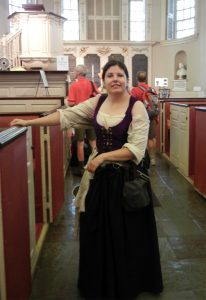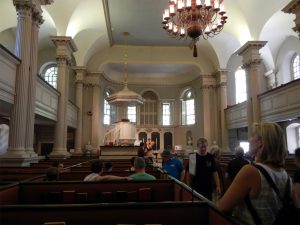“Tory Stories”
After attending the “No Tax on Tea!” program at the Old South Meeting House, I walked to nearby King’s Chapel, the first Anglican Church in Massachusetts.[1] The steeple-less, hand-hewn, granite-block church sits on the edge of Boston’s first burial ground. In 1686, Governor Edmund Andros thwarted the Puritans’ refusal to sell land to non-Puritans by using eminent domain to take part of the public burial ground for the construction of King’s Chapel. In 1749, the Chapel’s congregation commissioned Peter Harrison of Newport, Rhode Island to design a new, stone church to replace the wooden chapel Andros built. The church has always been steeple-less, at first because the congregation lacked the funds to build one, and later, because the steeple-less façade had become a defining feature of the church.[2]

During Harborfest, King’s Chapel staff offers “Tory Stories.” The program consists of two female re-enactors; one portrays Baroness Agnes Frankland (née Surriage), the Marblehead, Massachusetts barmaid who married Sir Charles Henry (“Harry”) Frankland, Baronet and the other plays Lady Margaret Gage (née Kemble), wife of Lieutenant-General Thomas Gage.[3] In the 1770s, both women worshipped at King’s Chapel. Together, Ladies Frankland and Gage regaled visitors with tales of the most famous King’s Chapel congregants.
Frankland began the program by defining the word “Tory.” According to Frankland “It’s a common misconception that back in the day, during the Revolutionary War, it was ‘us’ the Americans on this side of things and ‘them’ the English over in England and that’s not entirely true.” Frankland clarified, “A lot of people here [Massachusetts] considered themselves well and truly English, they were loyal to ‘King and Country,’ and wanted nothing to do with the Revolutionary War. Those Loyalists called themselves ‘Tories.’”[4] King’s Chapel offers “Tory Stories” because “No where in the city of Boston was that sentiment [Loyalism] felt more strongly than here in the King’s Chapel.” Approximately half of the seventy families who worshiped in King’s Chapel identified as Loyalists and departed for Nova Scotia with the British military on March 17, 1776, Evacuation Day.
Frankland and Gage provided approximately twelve different vignettes in their twenty-minute program. They began with the story of Reverend Henry Caner who served as the last Anglican minister of King’s Chapel.[5] Caner held church services until he evacuated with the military. In addition to his personal items, Caner took the Chapel’s communion silver and gold organ capitals with him to Halifax, Nova Scotia. King William III & Queen Mary had donated the gold capitals to the church. King’s Chapel recovered its capitals after the war, but Caner’s new congregation kept the communion silver.[6]
Catherine Gardner stood as a fervent Loyalist. In March 1776, she made her husband Sylvester, a lukewarm Patriot, pack their possessions for Canada. The Gardners and their children departed Boston with the British. Sylvester did not agree with the decision to leave, but he did not abandon his family. Instead he made a provision in his will for his body to be sent back to Boston and interred in King’s Chapel. After he died, his family sent his body to Boston and the King’s congregants buried him in the church crypt.[7]
Archibald McNeil decried the Revolution as a “bad idea” to anyone who would listen and even to those who would not. On Evacuation Day, McNeil made his way to Canada, where he lived throughout the war. When peace arrived in 1783, McNeil returned to Boston. The Patriots did not allow him resettle in their city. So McNeil tried to return to Canada, except “half way there the darndest thing happened. ‘Archie’ was set upon by the Natives” who scalped him.
Not all of the tales pertained to Loyalists. Lady Gage admitted that she might have had something to do with her husband being “drummed out of the British Army for incompetence following the battles of Lexington and Concord.” Historical anecdotes claim that Lady Gage supported the Patriot cause and leaked the details of the British march to Lexington and Concord to Dr. Joseph Warren, President of the Massachusetts Committee of Safety. Of course, Gage’s story fell short of an admission because “A ‘Lady’ never tells.”

The reputation of King’s Chapel as a “hotbed of Loyalism” caused its Patriot and Neutral congregants to close the church after Evacuation Day. Out of fear that their locks would not stop returning Patriots from looting and destroying their church, some of the congregants approached John Hancock and asked him to safeguard their painting of the Last Supper by Benjamin West. Hancock obliged them and returned the painting to the congregation after the war.
As the crowd filtered out of the church, I caught up with theater production artist Kat Kingsley, a.k.a Baroness Agnes Frankland. Seven years ago, Kingsley revamped “Tory Stories.” The program used to be a twenty-minute history talk. Kingsley and her scene partner wanted a more “fun and interactive” show “to present stories [that visitors] wouldn’t normally hear on the rest of the Freedom Trail.” So they sifted through the congregants’ stories to find tales that had both historic value and the ability to entertain visitors. After selecting their cast of characters, Kingsley and her partner researched the stories to ensure historical accuracy.
The original program told the story of Baroness Frankland “like a Cinderella Story: A poor barmaid, rich Baron falls in love, and sweeps her off, and makes her rich and educated.” Kingsley’s research into Frankland’s life told a different story. “In the King’s Chapel Annals we heard the rest of [her] story and that is when I learned ‘orgy’ was a colonial word. It was really fun to sort of hear the rest of it [her story].” Kingsley found Frankland to be “over the top” and therefore a natural lead for the show. “The story that I tell is 100 percent accurate.”
Kingsley aims for historical accuracy, but she is not afraid to embellish her portrayal with her inaccurate costume and language. “I find that humor is a wonderful tool to teach and if you can train people that history is not just names and dates but a collection of awesome stories, people retain the information much better. They retain so much that they wouldn’t have normally retained.”
When I asked Kingsley about the reception of the program she admitted that it has “six or seven ‘groupies’” defined as people who make an effort to see the show every year. In fact, Kingsley had just reconnected with a man who has seen the show “five years running” and whose kids have been so inspired that “his daughter is starting to do colonial re-enactment because she is in love with the show and his son wants to be a historian because the show.” It seems that visitors don’t mind hearing Loyalist-centered stories. Although I suspect that if Kinglsey and her colleague asked visitors to play a Loyalist they might meet with the same resistance that the educators at the Old South Meeting House occasionally experience.
Conclusions
I attended three of the four Loyalist-related Harborfest programs to better understand their paucity. At the outset, I posited that historic organizations in Boston did not offer them because they found it difficult to interpret Loyalist viewpoints. The evidence from “Whispers of Revolution” and “Tory Stories” suggests that my theory is incorrect. Re-enactors in both programs like to portray Loyalists as much as Patriots because it helps them improve their portrayal of both sides and provides them with a more meaningful connection with the history of the period.
My second theory claimed that organizations did not offer Loyalist-related events because they proved too unpopular with Harborfest attendees. It seems that this supposition has some merit. On occasion, the education staff at the Old South Meeting House experiences visitor hostility towards their assigned Loyalist role in the “No Tax on Tea!” program. However, these educators work hard to convert this overt hostility into curiosity. Their school and adult programs interpret the Revolution as a many-sided conversation and they encourage teachers, students, and program attendees to participate in that multi-faceted discussion through role-play. Their dialogue helps create a meaningful and lasting appreciation for all sides of the Revolution. Additionally, visitors seemed to enjoy and be receptive to non-interactive programs like “Tory Stories” and “Whispers of Revolution.”
The educators at the Old South Meeting House and King’s Chapel have taken the lead in helping Americans come to terms with the Loyalist history of the Revolution. Their more nuanced interpretations of the Revolution help Americans develop a better understanding of how Patriots, Loyalists, and Neutrals participated in and weathered the Revolution and War for Independence. It is important that Americans understand that the Patriots could have just as easily lost the war they won. To achieve this understanding, Americans must hear and consider all sides of the Revolution. When they do, they will be able to fully appreciate just how dangerous, dramatic, and revolutionary the Revolution really was.
[1] In 1782, King’s Chapel became a Unitarian house of worship. Today, it affiliates with the Unitarian Universalist Association.
[2] Charles Bahne, The Complete Guide to Boston’s Freedom Trail, 3rd ed. (Cambridge, Massachusetts: Newtowne Publishing, 2005), 13–16; “History – King’s Chapel,” accessed July 19, 2013, http://www.kings-chapel.org/history.html.
[3] A descendant of Oliver Cromwell, Sir Charles Frankland inherited the title of Baronet of Thrisk in North Reading, Yorkshire, England upon the death of his uncle, Sir Thomas Frankland.
[4] See Taylor Stroemer’s “Establishing the Tory Myth” for clarification on the origin and revolutionary-period use of “Tory.”
[5] King’s Chapel, “327 Years of Leadership,” accessed July 22, 2013, http://www.kings-chapel.org/327-years-of-leadership.html.








One thought on “Searching for Loyalists: Boston Harborfest (part 3)”
Sorry to have to say that Lady Frankland was not a baroness. That’s the wife of a baron, or a woman who has received the equivalent title, and Sir Harry was a baronet. As a courtesy people addressed the former Agnes Surriage as Lady Frankland.